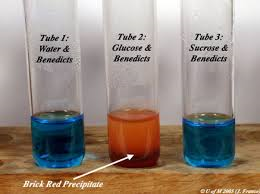This test is for finding whether the sugar is reducible or non reducible.It is both qualitative as well as quantitative test.This test is used for laboratory detection of different sugars as well as diabetes via urine test.
Principle of Benedict’s test:
When reducing sugars are heated in basic solution, they form powerful reducing compounds known as enedioles.Endiole further react with cupric ions which are present in Benedict’s solution to cuprous ions.Thus we detect the presence of reducing compounds.Here is should be noted that benedict’s solution not only react with reducing sugars but also give positive result with other reducing compounds.
Reagents for Benedict’s test:
Benedict’s solution contains:
- CuSO4
- Sodium citrate
- Sodium carbonate (Na2CO3)
How to Check quality of Benedict’s solution?
Before performing test it is necessary to test the purity of Benedict’s solution.
Benedict’s solution is blue in color .In order to check purity of Benedict’s solution take 5 ml of Benedict’s solution in test tube and heat it.If is does not change color, it means it is pure.
Procedure of Benedict’s test:
- Take 5 ml of Benedict’s solution in a test tube.
- Add 5-8 drops of original solution in the test tube containing Benedict’s solution and heat it.
- Upon boiling, it will change the color.If it doesn’t change color, it means the sugar in the original solution is non reducible.
Precautions:
Here are some of the precautions for Benedict’s Test:
- Measure the Benedict’s solution solution first.
- Don’t add much solution. Add only few drops.
- Heat the mixture gently.
- Don’t keep the test tube towards any human while heating. Upon boiling it could escape test tube and burn skin.
- Biol it few times before making any decision.
How to determine quantity of reducible sugar by Benedict’s test:
When can also determine the quantity of sugar in solution from Benedict’s test.
- If the co lour upon boiling is changed into green, then there would be 0.1 to 0.5 percent sugar in solution.
- If it changes color to yellow, then 0.5 to 1 percent sugar is present.
- If it changes to orange, then it means that 1 to 1.5 percent sugar is present.
- If color changes to red,then 1.5 to 2.0 percent sugar is present.
- And if color changes to brick red,it means that more than 2 percent sugar is present in solution.
This way we can find whether the sugar in solution is reducing sugar or not.And we can also determine the quantity as well up to some extent.
Results:
If the solution changes its color to green, yellow, orange, red or brick red upon boiling, then it means that results are positive and the solution contains reducing sugar.
If there is no color change upon boiling, then it means that NO reducing sugar is present in solution and result is negative.
Sucrose doesn’t show positive results with Benedict’s reagent but if we reduce sucrose with the help of acid then its products would should positive results with Benedict’s solution. This way, we can confirm the reduction of sucrose as well.

Thank you so much Hamza for this information
Why do we care about testing the reducing sugar content ?
Whay is the purpose of the test?
You will differentiate between reducing and non reducing sugars. After that you can perform other tests to find the exact sugar.
Why is Na2CO3 added to the solution before the Benedict’s test is performed?
it provides basic medium…
so that…..
What is the work of the Sodium citrate in the reagent
stabilizes the solution…
Why the spontaneous cooling in this Experiment
Why do reducing sugars in alkaline solution have strong reducing action on heavy metal ion
why in benedict test, heating for more than 2 minutes is not carried out?
i haven’t written anywhere in my post that you should not heat for more then 2 minutes. But 2 minutes are enough for reaction.
why is sodium bicarbonate added before the benedicts solution in finding a reducing sugar
probably for pH…but i will get back with more precise answer.
why we add only 5-8 drops of reagent not more than it?
because it is enough for the reaction.
Thanks Admin
We have to add reagent to the sample or saurine sample to reagent ? Plz xplain
add sample to reagent…
why the spontaneous cooling?
Why the spontaneous cooling in Benedict’s test
Could a positive Benedicts test occur without boiling if left for an extended period of time (72+hrs) at room temperature?
Thanks!
hi good ting